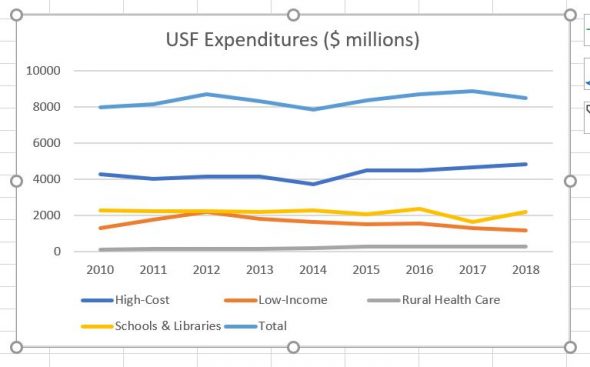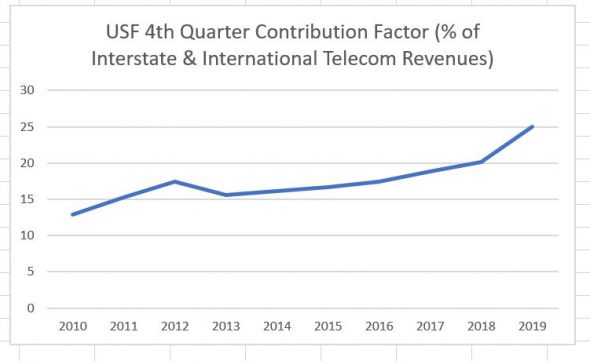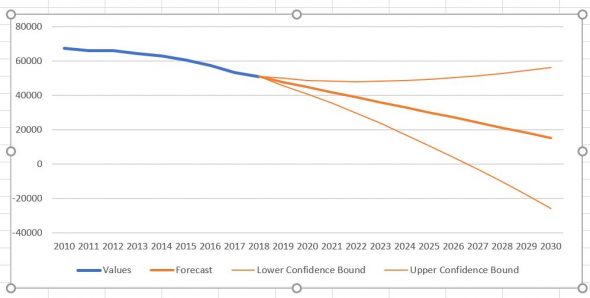Where Does Universal Service Fund Money Go
 The percentage of end user phone bills that goes toward the Universal Service Fund has been climbing and in that location are serious questions almost the sustainability of that funding machinery, despite a relatively stable USF upkeep. It's something Telecompetitor has warned almost previously, and in this post, we offer some factual numbers to illustrate our concerns.
The percentage of end user phone bills that goes toward the Universal Service Fund has been climbing and in that location are serious questions almost the sustainability of that funding machinery, despite a relatively stable USF upkeep. It's something Telecompetitor has warned almost previously, and in this post, we offer some factual numbers to illustrate our concerns.
The USF is actually iv carve up funds – the low-income Lifeline fund, the rural healthcare fund, the E-rate schools and libraries fund and the high-cost fund. The latter includes the Connect America Fund (CAF) and the mobility fund, and in the future will include the Rural Digital Opportunity Fund, which will replace the CAF.
The money for these funds comes from companies that offer interstate and international long-distance telecom services (i.e., vox services). At i time most of the money went toward vocalization services just over the years, more than and more of it has gone towards broadband. Service providers generally pass these costs on to consumers in their monthly phone bill.
Broadband revenues aren't considered telecom revenues, notwithstanding, which means that even though USF dollars go toward building and maintaining broadband networks and toward broadband service for low-income users and toward broadband to support schools, libraries and telehealth, all those programs are still funded as a pct of traditional telecom revenues.
Universal Service Fund Upkeep
The full money spent on the four USF programs has fluctuated somewhat over the years, merely thanks to spending caps, the total upkeep remains in the range of $8 billion annually.

Despite the relative flatness of USF expenditures, the contribution factor – the pct of carrier telecom revenues that goes toward USF – has been climbing. As of late 2010, the per centum of revenues that carriers had to pay into the fund – known as the contribution gene – was 12.ix%. Every bit of late 2019, that number had nearly doubled, climbing to 25%.

The reason for the steep climb in the contribution factor is simple: Carriers' interstate and international telecom revenues, known as the contribution base – have been declining.
The Contribution Base of operations
In 2010, the contribution base of operations was almost $72 billion. By 2019, information technology had fallen to $52.9 billion – and assuming the trend continues, those revenues could autumn below $twenty billion by 2030, at which point most one-half of service providers' interstate and international telecom revenues would exist going toward Universal Service. That's bold the USF budget remains flat at around $viii billion. If nosotros factor in even a pocket-size aggrandizement factor, the funding needed could hit or exceed l% of the contribution base.

A logical question is why the FCC doesn't aggrandize the contribution base to include broadband revenues, considering that the funding now is going, in big role, toward broadband. The answer is political.
Opponents position that move as "taxing the cyberspace" – a concept that undoubtedly wouldn't poll well, considering how many things come for free on the internet and considering that the average American probably would assume it means the coin would go into the general fund.
Possibly if the issue were better understood, it would have more support, and the idea of making these charts came, at least in office, with that goal in mind. (All data is from the 2019 Universal Service Monitoring Report.)
Perhaps there also are other ideas that could help address the situation. For example, some people have suggested allocating a portion of proceeds from various auctions to go toward rural broadband. That would seem to be a one-shot cash infusion, rather than a sustainable funding source, but maybe there is a way to collect the coin from licensees on an annual ground.
The important thing, information technology seems to me, is to commencement thinking about this now.
Source: https://www.telecompetitor.com/is-universal-service-fund-in-peril-a-close-look-at-the-budget-and-where-the-money-comes-from/
Posted by: stoverthistarry.blogspot.com


0 Response to "Where Does Universal Service Fund Money Go"
Post a Comment